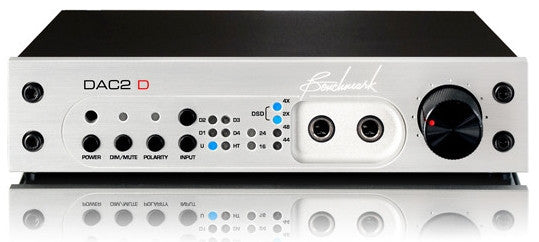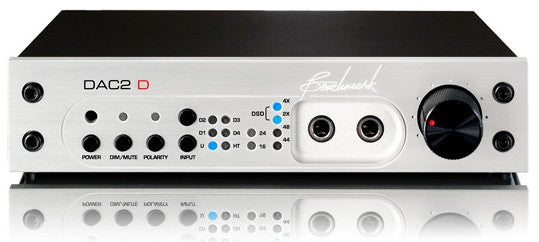
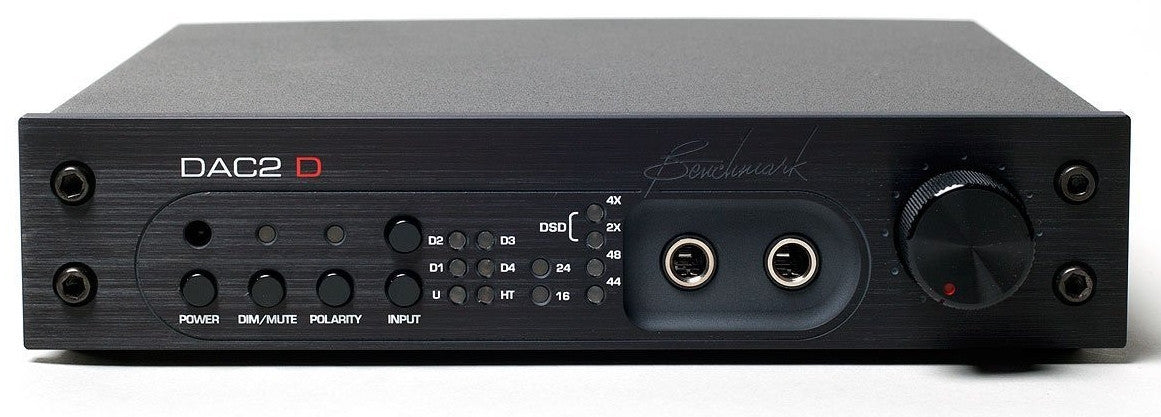
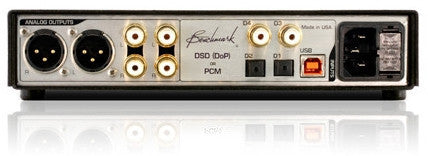
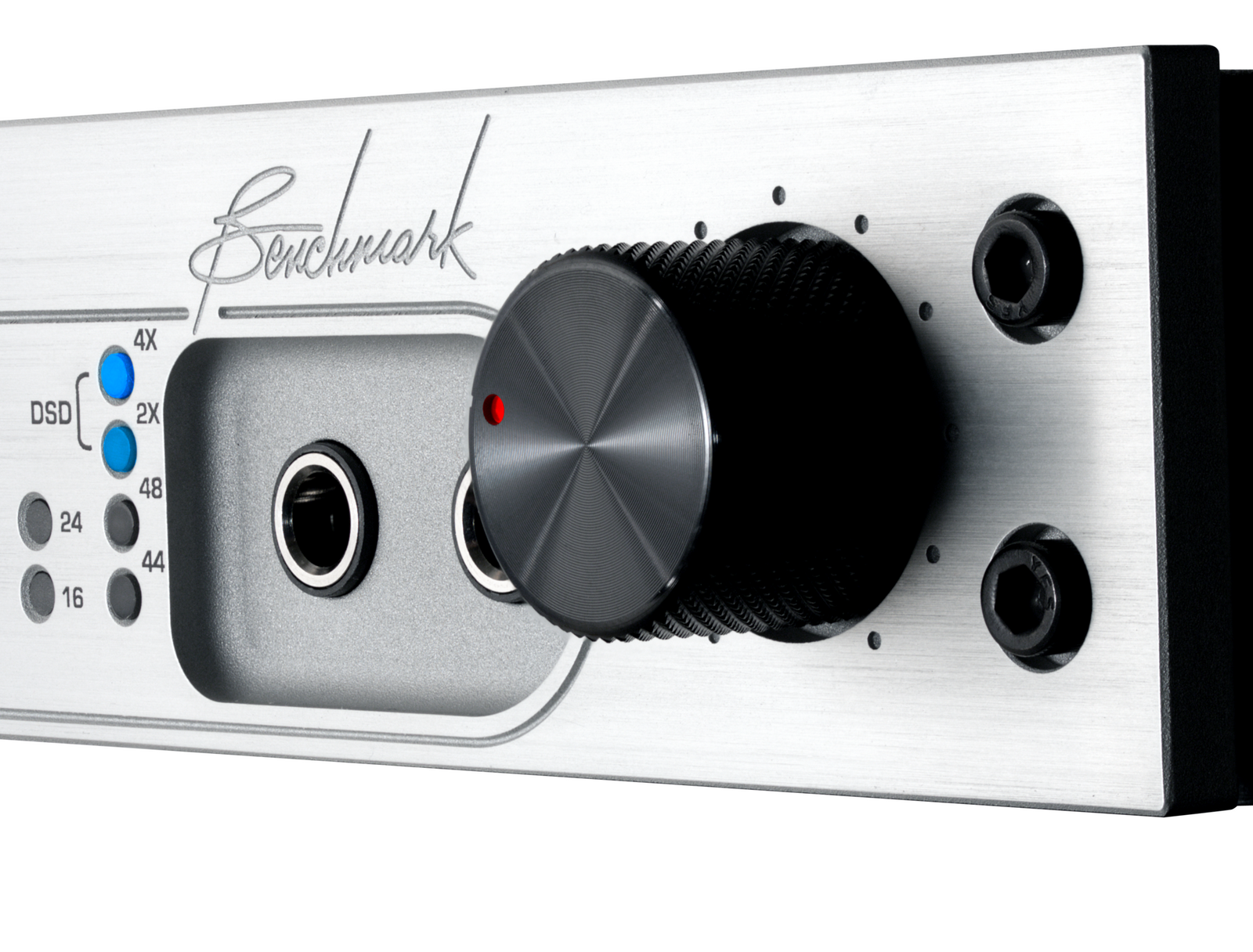
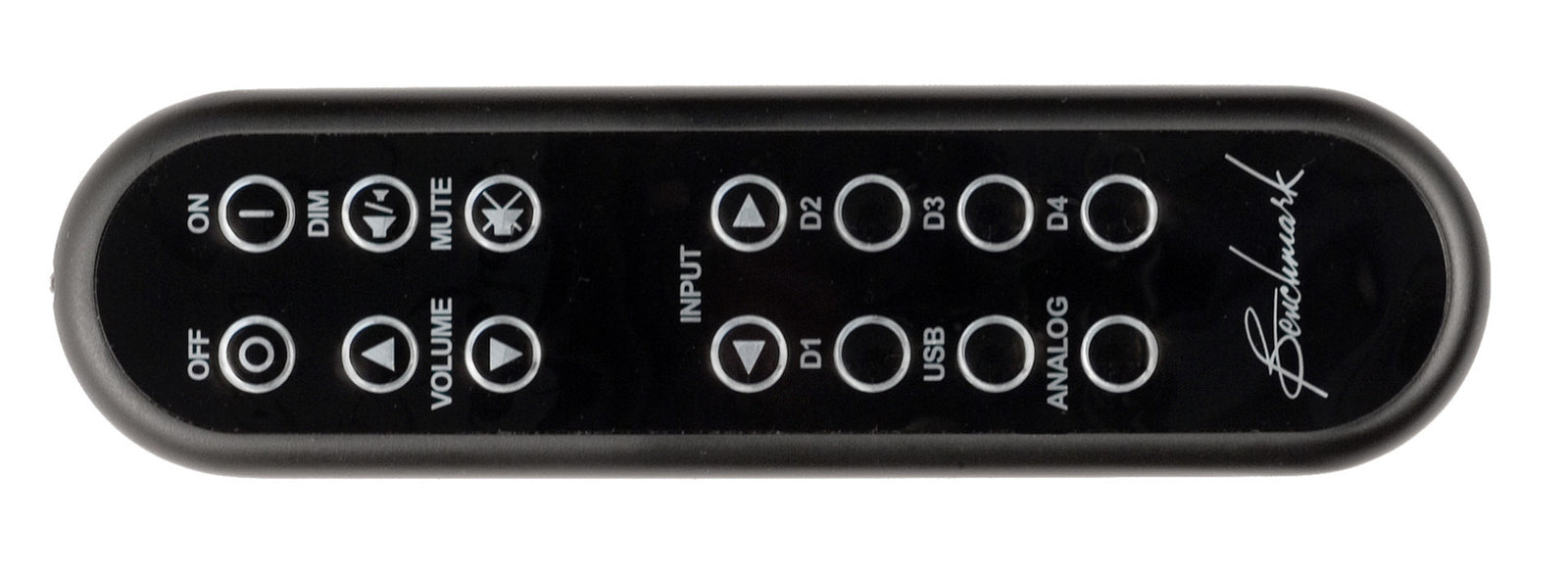
500-15100-100
Benchmark DAC2 D - Digital to Analog Audio Converter - Discontinued
The DAC2 D has been replaced with the DAC2 DX. The DX has additional features including an AES digital input.
DAC2 D
"In essence, the DAC2 D offers the same dynamic accuracy, yet warm, smooth analog character as the "HGC.""
- John Gatski, Everything Audio Network- Greg Weaver, Positive Feedback Writer's Choice Award for 2013
DESIGNED, ASSEMBLED, AND TESTED IN THE USA
This Benchmark product was designed, assembled, and tested in the USA using USA and imported components. Most major components are made in USA.
Performance
The DAC2 is Benchmark's new 2-channel D/A converter. The DAC2 converter has lower noise, lower distortion, and improved accuracy when compared to Benchmark's outstanding DAC1 converter. The DAC1 has become a reference standard in many of the finest recording studios and mastering rooms. The DAC2 defines a new reference.
DAC2 converters deliver outstanding musical detail and precise stereo imaging. They employ an advanced high-headroom digital filter design, and a new high-sample-rate Asynchronous USB Audio interface. All inputs are fully isolated from interface jitter by Benchmark's new UltraLock2™ jitter attenuation system.
Internal digital processing and conversion is 32-bits, and includes 3.5 dB of headroom above 0 dBFS. Four balanced 32-bit D/A converter are summed together for each balanced output. The performance of the DAC2 exceeds the measurement limits of today's state-of-the art test equipment.
Native DSD Conversion
All digital inputs on the DAC2 D support native DSD conversion. DoP 1.1 is automatically detected on all digital inputs, and the system seamlessly switches to native DSD conversion. DoP 1.1 is supported by many media players, and DSD downloads are now available from several sources.
Direct Connectivity to Power Amplifiers
Benchmark DAC1 and DAC2 converters are designed to directly drive power amplifiers an speakers. Benchmark converters feature adjustable low-impedance passive attenuators at the XLR outputs that can be used to optimize the interface to the power amplifier (or powered monitor).
Sonically Neutral
All Benchmark converters are designed for maximum transparency. This transparency is absolutely essential in the studio monitoring chain. DAC2 converters are ideal for critical reference-quality professional systems.
Take the Studio Home
When Benchmark's professional converters are used in hi-fi applications, studio-quality sound can be enjoyed in a home environment.
Discover the natural, uncolored, analog sound of the DAC2.
DAC2 D Features
- Sample Rate Display
- Word Length Display
- More Digital Inputs (5 total)
- More Analog Outputs (3 total)
- Digital Pass Through
- Native DSD Conversion
- Polarity Switch
- Asynchronous USB 2.0
- Driverless Asynchronous USB 1.1
- Home Theater Bypass
- Power Switch
- Low Power Consumption
New Benchmark Technologies
Benchmark introduces some exciting new technologies in the DAC2:
- Hybrid Gain Control
- High-Headroom DSP
- UltraLock2™ Jitter Attenuation System
- Quad 32-bit balanced D/A Conversion System
- Multi-Mode Asynchronous USB Audio System
- Distributed Power Regulation
Hybrid Gain Control
The DAC2 D combines active analog gain control, passive low-impedance attenuators, a 32-bit digital gain control, and a servo-driven volume control. All inputs are controlled by the rotary volume control. This volume control moves in response to commands from the remote control. Digital inputs never pass through an analog potentiometer, and analog inputs are never converted to digital. Digital inputs are precisely controlled in the 32-bit high-headroom DSP system. The DSP system preserves precise L/R balance, and precise stereo imaging, while avoiding any source of noise and distortion. Benchmark's unique passive output attenuators provide distortion-free gain reduction without reducing the dynamic range of the converter. The attenuators optimize the gain staging between the DAC2 D and the power amplifier. This optimization is absolutely essential for maximizing the dynamic range of the entire playback system. Much of the success of the DAC1 converters can be attributed to the passive output attenuators. Musical details can be obscured by system noise whenever a preamplifier and power amplifier are improperly matched. The" HGC " system will make full use of your power amplifier's dynamic range. Experience new details in your favorite recordings.
UltraLock2™ Jitter Attenuation System
UltraLock2™ is an improved version of the UltraLock™ system used in the DAC1 and ADC1 product families. DSP processing is 32-bits, DSP headroom is 3.5 dB, sample rate is 211 kHz, and jitter-induced distortion and noise is at least 140 dB below the level of the music - well below the threshold of hearing. Benchmark's UltraLock2™ system eliminates all audible jitter artifacts.
High Headroom DSP - with 3.5 dB "Excess" Digital Headroom
All of the digital processing in the DAC2 D is designed to handle signals as high as +3.5 dBFS. Most digital systems clip signals that exceed 0 dBFS. The 0 dBFS limitation seems reasonable, as 0 dBFS is the highest sinusoidal signal level that can be represented in a digital system. However, a detailed investigation of the mathematics of PCM digital systems will reveal that inter-sample peaks may reach levels slightly higher than +3 dBFS while individual samples never exceed 0 dBFS. These inter-sample overs are common in commercial releases, and are of no consequence in a PCM system until they reach an interpolation process. But, for a variety of reasons, virtually all audio D/A converters use an interpolation process. The interpolation process is absolutely necessary to achieve 24-bit state-of-the art conversion performance. Unfortunately, inter-sample overs cause clipping in most interpolators. This clipping produces distortion products that are non-harmonic and non-musical . We believe these broadband distortion products often add a harshness or false high-frequency sparkle to digital reproduction. The DAC2 D avoids these problems by maintaining at least 3.5 dB of headroom in the entire conversion system. We believe this added headroom is a groundbreaking improvement.
Multi-Mode Asynchronous USB System
Benchmark's USB system supports USB Audio 2.0, DSD, and USB Audio 1.1. It is frequency agile, and will follow sample rate changes initiated by the computer and/or the media playback software. In all modes the USB communications are asynchronous in order to eliminate unnecessary sources of jitter.
The DAC2 D has a low-jitter master clock which controls the transfer of audio data from the computer to the USB sub-system. The computer asynchronously transfers audio data to a buffer in the DAC2 D. The contents of the buffer are then asynchronously transferred to the D/A conversion sub-system. This second asynchronous transfer eliminates any traces of jitter that accumulate as the data is transferred between the USB and conversion subsystems. No traces of jitter-induced distortion are measurable to our measurement limits (better than -150 dBFS). This truly represents the state-of-the art. Enjoy the convenience of computer playback without compromise. The Asynchronous USB system supports USB Audio 2.0 for high-resolution 192kHz, and DSD playback. No drivers are required for MAC operating systems. An easy-to-install driver adds 192 kHz and DSD capabilities to Windows operating systems.
An asynchronous, driverless USB Audio 1.1 mode supports sample rates up to 96 kHz. This USB mode can be selected from the front panel or from the remote control. The driverless USB Audio 1.1 mode allows quick plug-and-play connections to Windows, MAC, iOS, and Linux operating systems without installing drivers. Just plug in the USB, and the DAC2 D becomes an available audio device.
The USB subsystem remains active when the DAC2 D is powered down. This prevents interruptions to the computer playback operations and eliminates the need to reconfigure the computer every time the converter is turned on.
Quad 32-bit Balanced Conversion System
Four balanced 32-bit D/A converters deliver audio to Benchmark's low-impedance current to voltage converters. The 4:1 redundancy reduces noise and distortion to levels that set new benchmarks. The conversion system at the core of the DAC2 D is as good as it gets. The analog circuits that follow the D/A converter are carefully designed. Benchmark has leveraged its long history of building high-end analog audio equipment, in order to create an outstanding output stage.
Diagnostic Tools - Sample-Rate and Word-Length Indicators
Ever wonder why that 192 kHz 24-bit download on your computer just doesn't sound right? Your media player may be down-sampling to 44.1 kHz and/or truncating to 16-bits. Many media players apply poor-quality sample rate conversion and truncation. Fortunately these problems can be eliminated with the selection a good frequency-agile media player. The sample-rate and word-length displays on the DAC2 D confirm the proper operation of your media player.
Polarity Switch
You may encounter recordings with inverted polarity. The DAC2 D includes a polarity switch to correct the problem.
Home Theater Bypass
The DAC2 D can be integrated into a home theater system. Typically the DAC2 D drives the left and right power amplifiers. A programmable Home Theater Bypass function sets the pass-through gain to unity when the surround system is active. The DAC2 D includes an indicator light that is illuminated when bypass is active.
Digital Pass Through
The second coaxial input can be reconfigured as a digital output. In output mode, any selected digital input (including USB) will pass through to the coaxial output. The digital pass through is bit-transparent and even supports DSD (DoP 1.1). Dolby digital and DTS formats can be passed through to a surround processor.
Power Switch
The power switch can place the DAC2 D in standby, or full shut down. Power consumption is less than 0.5 W in full shut down.
Low Power Consumption
The DAC2 uses high-efficiency low noise power supplies and may be operated from any standard international voltage without adjustment. Power consumption is 12 W typical.
Distributed Power Regulation
To achieve the lowest possible noise, the DAC2 D uses distributed power supply regulation. Each critical subsystem has at least one dedicated low-noise voltage regulator.
Specifications
SNR: 126 dB, A-Weighted
SNR: 123 dB, Unweighted
THD+N: -109 dB, 0.00035% (1 kHz, 0 dBFS)
THD+N, -108 dB, 0.00040% (20 to 20 kHz sweep at - 3 dBFS)
Frequency Response: +0 dB/-0.04 dB (20 to 20 kHz at Fs=96 kHz )
Manual
Detailed specifications and performance plots are available in the downloadable manual.
Reviews
Driver
Windows operating systems require a driver when operating in USB 2.0 mode (required for 192 kHz operation). No driver is required for Mac or Linux operating systems. No driver is required for any operating system when operating in USB 1.1 mode (sample rates up to 96 kHz).
Add Benchmark Cables to Complete You New System
Benchmark offers a no-nonsense selection of very high-quality cables. Benchmark cables are designed for durability and transparency, and most are manufactured in the USA. Our optical cables are manufactured in Canada.
Add a Rack-Mount Kit
All Benchmark DAC1, DAC1, ADC1, and MPA1 products are housed in a 1/2-wide 1 RU chassis. Two units can be mounted side-by-side in a 1-RU tray.
HPA2™ Headphone Power Amplifier
The DAC2 features the HPA2™ - Benchmark's signature high-current, 0-Ohm headphone power amplifier. The HPA2™ is arguably the ultimate reference headphone power amplifier. It will deliver the full rated performance of the DAC2 to the headphones. The HPA2™ maintains less than 0.0003% THD+N under full load. The DAC2 has two 1/4" headphone jacks on the front panel. The performance of the HPA2™ remains consistent even when two headphones are being driven simultaneously.
DESIGNED, ASSEMBLED, AND TESTED IN THE USA
This Benchmark product was designed, assembled, and tested in the USA using USA and imported components. Most major components are made in USA.



